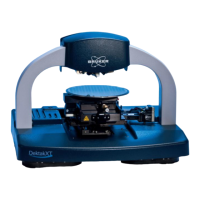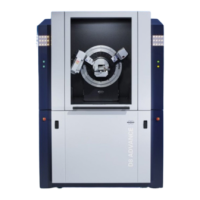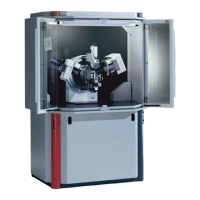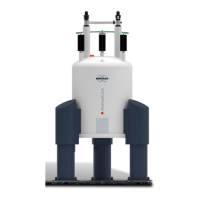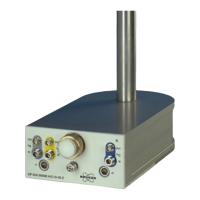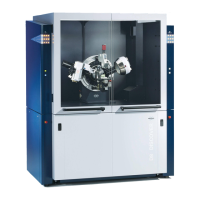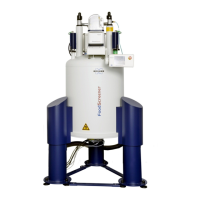D2 PHASER User Manual
DOC-M88-EXX141 V5 – 01.2015 17
write it down. In case of ‘Reference Determination’ press ‘Apply’ in order to accept these values
(fig. 55).
6. Check your reference determination with a new scan. Select a smaller range for 2
if desired (fig.
56). Press ‘reference determination’ again and check whether the result is satisfying as shown, for
example, in fig. 57 for reference determination. Normally, the reference determination is finished
after 2 iterations.
7. Insert and mount (properly) beam stop absorber module again (see section ‘Avoiding Collisions
with the D2 PHASER Goniometer’)
If anything was going wrong and the peaks are not at the position which you want, repeat the glass slit
scan, select ‘Reference And Offset Determination’, go to ‘Reference’ and enter the value you have
written down at step 4. above in the field ‘New Reference’, then press ‘Apply’. Then you have the
original status before reference determination.
D2 PHASER user alignment with 0D-detector (Scintillation Counter and XFlash detector) and
standard sample holder
The primary and secondary Soller and slit holder system is preset and aligned at Bruker AXS factory
and fixed with a sealed screw (X-ray radiation safety!). The beam will pass the primary 0.1mm slit, the
glass slit and a secondary 0.1mm antiscatter slit or receiving slit, respectively, simultaneously at zero
position (fig. 45). The user must follow the steps of the alignment procedure described in the following:
1. Open the front door. Release the sample holder (fig. 51) and insert the glass slit module (fig. 48, fig.
49, fig. 50). Check whether the direct beam groove in the sample holder ring (fig. 51) is in beam
direction. Lift the sample holder back to the goniometer’s centre position (fig. 52). Close the front
door and move ‘phi’ to zero position (fig. 58). If necessary, initialize the rotation motor by clicking on
the ‘init’-button. If so, check again whether the direct beam groove is in direction of glass slit (fig. 53)
and direct beam respectively. Insert an absorber (Cu for Cu-radiation) into the holder position of the
Scintillation Counter (fig. 35). Close the door again and lock it by switching on HV.
2. Set the range of 2 from -1.0° to 1.0° (if the beam is not in this range then try a larger range), step
width to 0.01° and scan time to 0.1s with ‘locked coupled’ as scan type and ‘continuous psd fast
scan’ as scan mode (fig. 54). The screenshot fig. 55 shows an example of a scan where the glas
slit peak is shifted with respect to the zero of the 2
scale.
3. Move to ‘reference and offset determination’ and then ‘reference’. This window shows the
calculated peak position relative to the current scale. Press ‘apply’ in order to accept these values
(fig. 55).
4. Move to ‘Reference And Offset Determination’ and go to ‘Reference’. This window shows the
determined peak position relative to the current scale. Read the Value ‘Current Reference’ and
write it down. In case of ‘Reference Determination’ press ‘Apply’ in order to accept these values (fig.
55).
5. Check your reference determination with a new scan. Select a smaller range for 2
if desired (fig.
56). Press ‘reference determination’ again and check whether the result is satisfying as shown, for
example, in fig. 57. Normally, the reference determination is finished after 2 iterations.
6. Insert and mount (properly) beam stop absorber module again (see section ‘Avoiding Collisions
with the D2 PHASER Goniometer’)
Setting the parameters of the detector unit
Before you can start your work or even to align your diffractometer system, the parameters of the
detector electronics should be checked. In general these parameters are factory set and need not be
adjusted.
1. Detector high voltage (HV): For 1D-LYNXEYE, the signals and the amplification of the detector
depend on the HV. Best results may be expected with 120V. Other HV settings can destroy the
detector. For 0D-scintillation counters, the mutual dependence of HV and the Amplifier Gain are
optimized for any detector at factory.
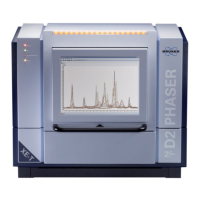
